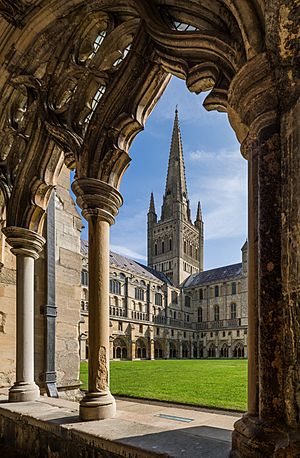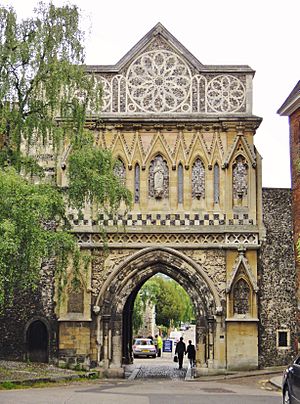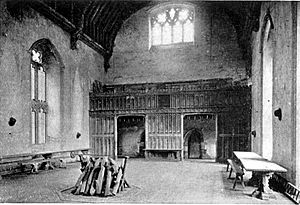William de Ramsey facts for kids


William de Ramsey was a very important English master mason and architect who lived in the 1300s. He was active from about 1323 until he died in 1349. He is famous for working on, and probably inventing, the "Perpendicular" style of Gothic architecture. This style became very popular in England for the next 300 years.
If William de Ramsey truly invented this style, he was one of the most influential architects England has ever had. His work changed how buildings looked for centuries.
Contents
Who Was William de Ramsey?
William de Ramsey was the son of John de Ramsey. His father was also a master builder, known as the Master of Works at Norwich Cathedral. John de Ramsey probably also helped build Ely Cathedral between 1324 and 1330.
William started his own career in the 1320s. He worked with his father on the cloisters at Norwich Cathedral. He also likely helped build the chapel above St Ethelbert's Gate, which led into the cathedral area.
William's Early Career and Key Projects
In 1323, William de Ramsey was working on St Stephen's Chapel. This chapel was part of the old Palace of Westminster in London, but it has since been destroyed.
Between 1326 and 1331, he also worked as a special advisor, or 'Visiting Master,' at Norwich Cathedral. This shows he was already highly respected for his skills.
Designing Important Buildings
In 1332, William de Ramsey designed the chapter house for Old St Paul's Cathedral in London. A chapter house is a building used for meetings by the clergy (church leaders). This building is also no longer standing.
By 1337, he was asked for advice on the design of the presbytery at Lichfield Cathedral. A presbytery is the part of a church where the main altar is located. In the same year, he was put in charge of supervising the building work at St Stephen's Chapel.
We know from old drawings and remaining pieces that the chapter house at St Paul's and St Stephen's in Westminster were built in the Perpendicular style. These were the very first buildings to use this new and exciting architectural design.
Royal Appointments and Later Works
William de Ramsey was also involved in important royal projects. In 1335, he was one of four experts who wrote a report about the Tower of London.
The next year, he was made the Chief Mason of the Tower of London. He also became the Chief Surveyor of the King's Works for the Tower and all royal castles south of the River Trent. This was a job for life, showing how much the King trusted his abilities.

It is also believed that William de Ramsey designed the great hall and other parts of Penshurst Place in Kent. This work was done between 1341 and 1348.
The Ramsey Family Legacy
William de Ramsey came from a family of master masons. According to historian John Harvey, the de Ramsey family's work can be seen in many famous places. These include Ramsey Abbey, Norwich Cathedral, and Ely Cathedral. Some even think they might have worked on buildings in Paris.
Sadly, William de Ramsey died in 1349 from the Black Death. This terrible disease, a type of plague, swept across Europe at that time. After his death, his daughter, Agnes Ramsey, continued to run his workshop.

